pH meters measure pH better than test strips, offering precision to 0.01-0.1 pH units compared to strips' 0.5-1.0 unit accuracy. You'll get more reliable results with meters since they eliminate the color interpretation subjectivity of strips. While meters require calibration and cost more ($20-$500+), they're essential for advanced soap makers needing precise measurements. Test strips remain useful for beginners and initial testing due to their simplicity and affordability. The choice ultimately depends on your specific soap making needs.
What Measures Ph Better: Test Strips or Meters?
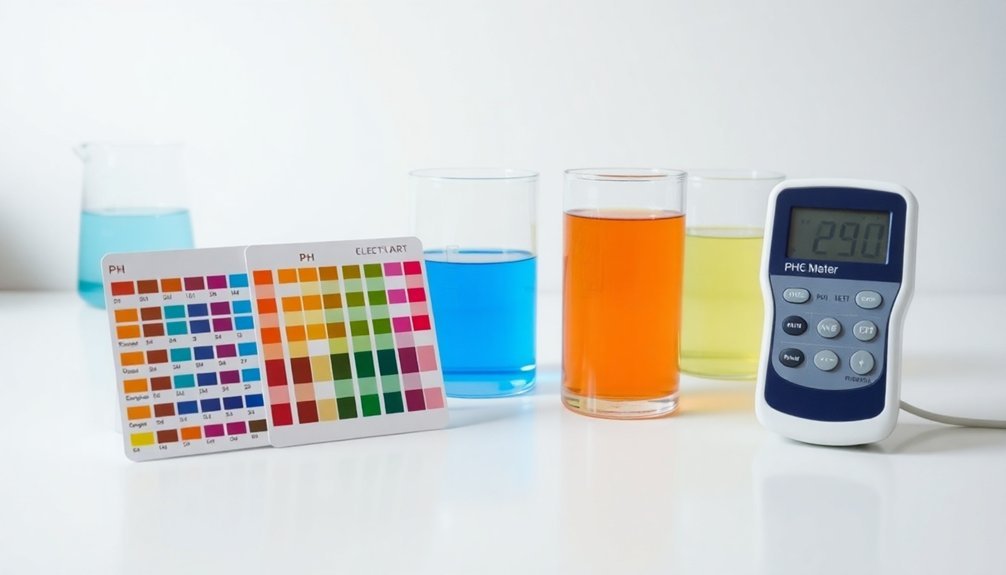
When choosing between pH test strips and meters, accuracy becomes the defining factor. pH meters clearly outperform test strips in precision, offering resolution down to 0.1 pH units compared to test strips' 0.5-1.0 unit range.
If you're seeking to measure pH with consistent reliability, you'll find digital meters eliminate the subjectivity inherent in interpreting color changes on test strips.
While test strips provide convenience and affordability for casual testing, they can't match meters' objective readings.
For applications where precise pH values matter, meters deliver superior performance through required calibration with buffer solutions. They also excel in dynamic environments by monitoring pH changes continuously, unlike test strips that only provide single measurements.
Your decision ultimately depends on balancing the need for accurate pH readings against budget constraints.
The Science Behind Ph in Traditional Soap Making
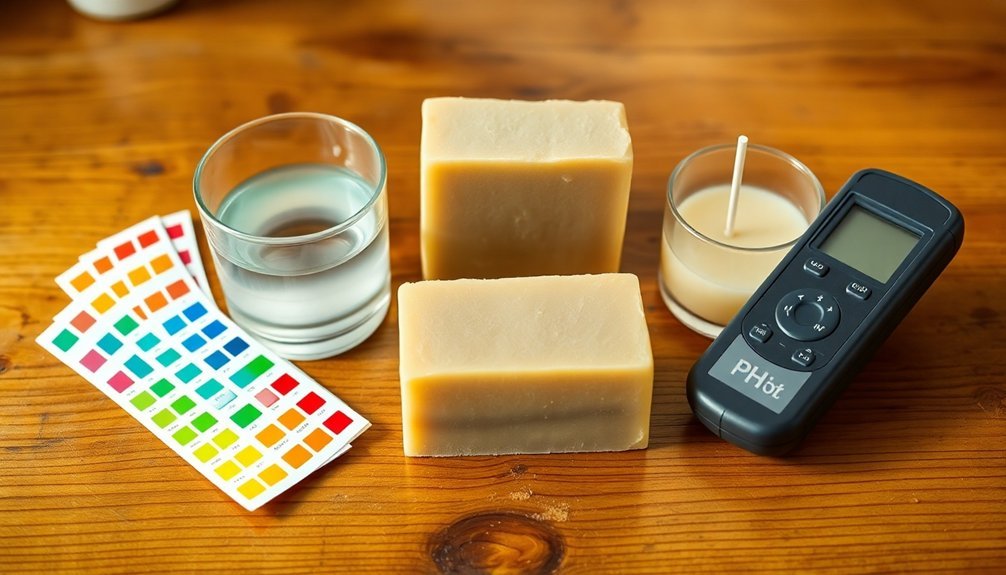
Soap making illustrates exactly why precise pH measurement matters. When you combine fats with sodium hydroxide, the saponification process requires a pH between 9 and 10 for success. Getting this wrong can result in irritating or ineffective soap.
pH testing becomes critical at multiple stages of production. While pH strips offer convenience for quick assessments, they don't provide the precision that professional soap makers need. pH meters deliver more accurate readings, allowing you to make precise adjustments to your formulation.
Many artisans start with strips for initial checks but rely on meters for final verification. This dual approach helps guarantee your finished soap achieves the proper alkalinity without excessive lye that could harm skin.
Understanding Traditional Lye Soap Ph Requirements
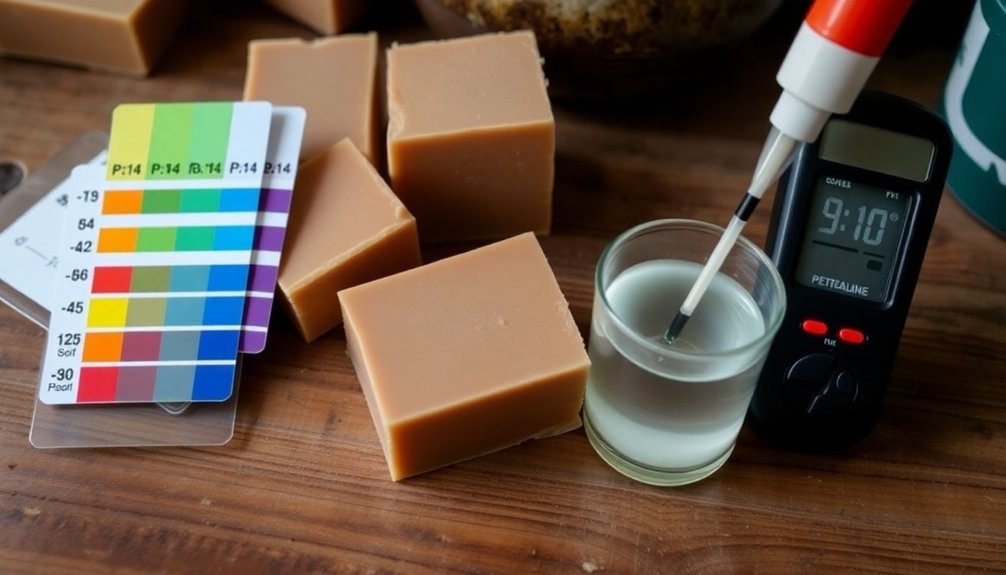
Traditional lye soap requires careful pH management to achieve both safety and effectiveness. When you're making lye soap, you'll need to maintain pH levels between 9 and 11, with 10 being ideal for balancing cleansing power with skin gentleness.
To guarantee your soap has completed saponification and is safe to use, you must measure the pH accurately. While test strips offer a quick assessment, digital pH meters provide more precise readings that help you confirm your soap is lye-free.
These meters require regular calibration to maintain accuracy throughout your soap-making journey. Monitoring pH isn't just a one-time task—it's an ongoing process that helps you identify and correct issues with excess lye before they cause skin irritation or other problems in your final product.
How Ph Test Strips Work for Soap Testing
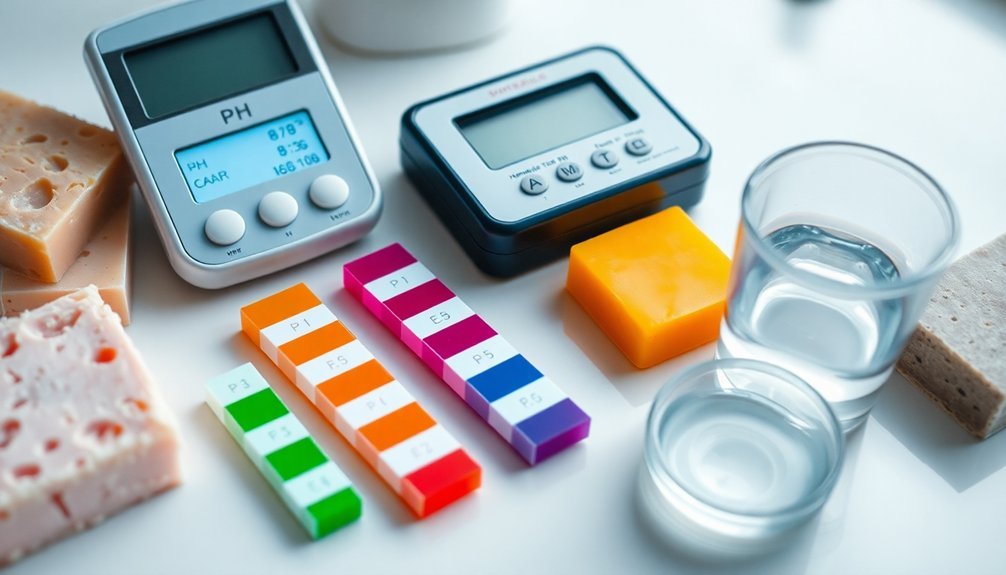
pH test strips provide a chemical window into your soap's acidity level through a simple color-changing process. When you place a small sample of your soap solution onto these strips, special dyes react to the hydrogen ion concentration, causing the strip to change color within seconds.
To measure your soap's pH, simply compare the resulting color against the standardized chart provided with your strips. These tools typically span the full pH scale from 0 to 14, making them versatile for various soap formulations.
For most handcrafted soaps, you'll want to achieve pH values between 9 and 10 for ideal cleansing without irritation.
While pH test strips offer quick, easy results, be aware that lighting conditions and the soap's natural color can sometimes affect your reading's accuracy.
Digital Ph Meters: Technology and Application in Soap Making
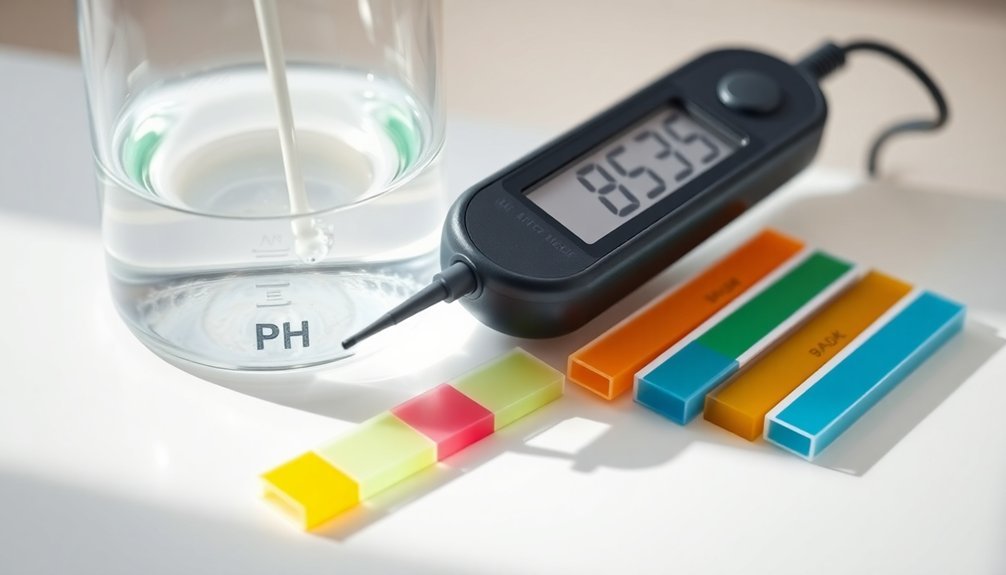
Unlike their paper counterparts, digital pH meters offer soap makers unprecedented precision with readings accurate to 0.01 pH units. This high resolution is essential when formulating soaps that must maintain a pH between 4.5 and 5.5 for skin safety.
When you're making soap, these meters allow you to monitor pH levels continuously throughout the process, allowing real-time adjustments to your formulations. The accuracy of pH meters far exceeds that of test strips, giving you confidence in your measurements.
Regular calibration guarantees your meter maintains its reliability, preventing inconsistencies that could compromise soap quality.
The durability of digital pH meters makes them a worthwhile investment for serious soap makers who need repeatable, consistent measurements across multiple batches.
Accuracy Comparison: Test Strips vs. Meters for Soap Ph
Many soap makers face a critical choice when measuring pH levels in their products. When comparing accuracy, pH meters greatly outperform test strips, offering precision within 0.01 to 0.1 pH units versus the 0.5 to 1.0 unit variance with strips.
Your soap's coloration can interfere with test strip readings, making it difficult to distinguish the exact color change that indicates pH reading. Meters eliminate this problem by providing objective digital results regardless of soap color.
While meters require proper calibration with buffer solutions to maintain their superior accuracy, this extra step pays off in reliability.
You'll also benefit from continuous pH monitoring during the soap-making process with meters, whereas strips only provide single-point measurements.
For consistent, precise pH control in soap making, digital pH meters are the clear winner.
Cost and Accessibility Factors for Soap Makers
When deciding between pH testing options, soap makers must carefully weigh cost against accuracy needs. pH test strips offer remarkable value, typically providing 100 strips for a fraction of what you'll invest in even basic digital equipment.
While strips are widely accessible at local stores and online retailers, pH meters range from $20 to over $500 depending on quality and features.
For beginners or hobbyists, test strips deliver adequate results without breaking the bank or requiring technical know-how. You won't need to calibrate them or purchase maintenance solutions.
However, as your soap making advances, you might find the precision of a digital pH meter justifies the higher initial investment.
Consider your production volume, required accuracy, and budget constraints when choosing between these accessible yet differently priced pH measurement options.
Best Practices for Testing Soap Ph at Different Stages
Testing your soap's pH at strategic points throughout production guarantees both safety and quality in your final product. For ideal results, use calibrated pH meters during the saponification process when precision matters most, particularly when fine-tuning formulations.
| Production Stage | Tool | Ideal pH | Best Practice |
|---|---|---|---|
| Initial Mix | pH meter | 10-14 | Test immediately after mixing |
| 24-48 Hours | pH meter | 8-10 | Monitor as saponification progresses |
| 1 Week | pH test strips | 7-10 | Quick assessment for general range |
| 4-6 Weeks (Cured) | pH meter | 7-9 | Final test in controlled temperature |
While pH test strips offer convenience for quick checks, they can't match the accurate and precise readings of a digital meter. Always test your cured soap after 4-6 weeks when pH levels have stabilized.
Troubleshooting Common Ph Testing Issues in Soap Making
Even experienced soap makers encounter frustrating pH testing problems that can compromise product quality and safety.
When your pH meter delivers inconsistent readings, check if it's properly calibrated with standard buffer solutions—this simple step greatly improves accuracy.
Test strips might seem convenient, but they're susceptible to human error, especially with colored soaps that interfere with visual interpretation.
For reliable results, consider upgrading to a digital pH meter.
Don't overlook expired test strips, which often yield misleading readings.
Handle pH meters carefully, as damaged electrodes produce erroneous measurements.
Remember that temperature considerably affects pH readings.
Allow your soap sample to cool to room temperature before testing to guarantee consistency, whether you're using strips or meters.
Frequently Asked Questions
Are Ph Meters More Effective Than Ph Test Strips?
Yes, pH meters are more effective than test strips. You'll get higher accuracy, precision, and consistent readings. They're less subjective, allow continuous monitoring, and provide reliable results despite needing calibration and maintenance.
Which Method Is More Accurate Ph Paper or Ph Meter?
pH meters are more accurate than pH paper. You'll get higher precision (0.01-0.1 units vs 0.5-1.0 units), more objective readings, and less interference from colored liquids when you use a digital meter.
What Is the Most Accurate Way to Test Ph?
For the most accurate pH testing, you'll want to use a calibrated digital pH meter. They provide higher resolution (0.01-0.001 pH units), eliminate subjective color interpretation, and allow real-time monitoring of pH changes.
Why Is a Ph Meter Better Than a Ph Indicator?
A pH meter is better than an indicator because you'll get more precise readings (down to 0.01 units), objective digital results without color interpretation issues, and consistent accuracy through calibration. It's worth the investment.
In Summary
For traditional soap testing, you're better off using digital pH meters when accuracy is critical, especially during formulation. While test strips are convenient and affordable for routine checks, they don't match meters' precision. Consider your specific needs—if you're a casual soap maker, quality strips may suffice, but for professional production, invest in a calibrated pH meter to guarantee your traditional lye soap meets proper pH requirements.

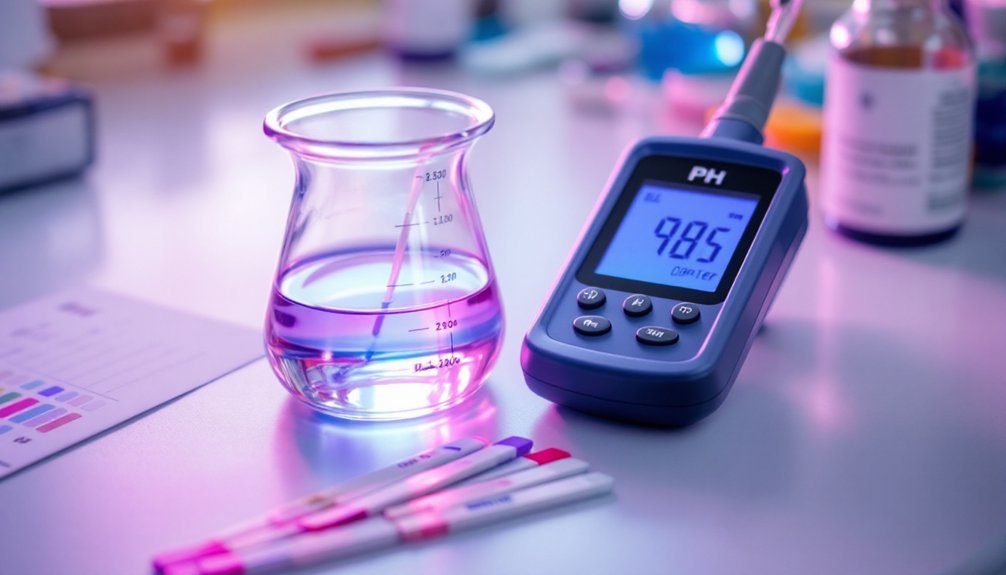

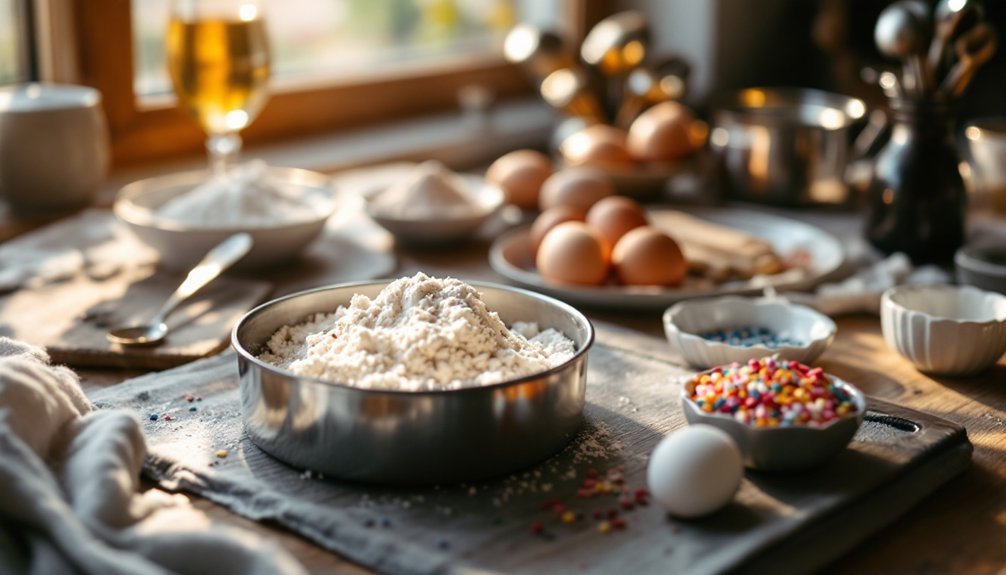
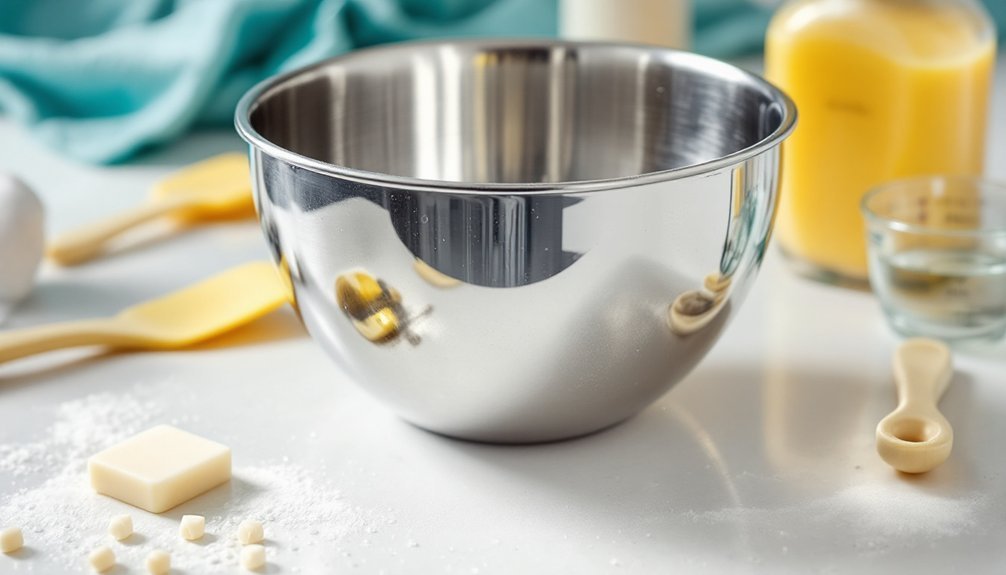
Leave a Reply